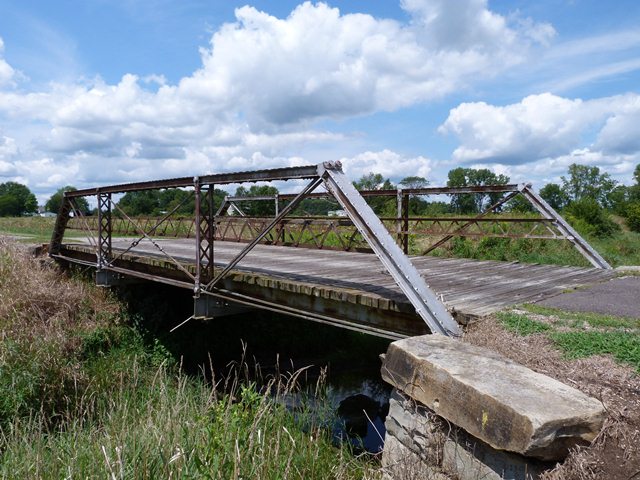We Recommend:
Bach Steel - Experts at historic truss bridge restoration.
BridgeHunter.com Phase 1 is released to the public! - Visit Now
Edgington Road Bridge

Primary Photographer(s): Nathan Holth
Bridge Documented: August 12, 2012
Rural: Morrow County, Ohio: United States
By Builder/Contractor: Wrought Iron Bridge Company of Canton, Ohio
1990
39.0 Feet (11.9 Meters)
40.0 Feet (12.2 Meters)
13.8 Feet (4.21 Meters)
1 Main Span(s)
5930723

View Information About HSR Ratings
Bridge Documentation
View Archived National Bridge Inventory Report - Has Additional Details and Evaluation
This bridge is an excellent example of a pony truss built by the Wrought Iron Bridge Company. It uses a design that the company employed frequently that includes unusual details. These details include threaded rod with nut connections for the diagonal members to the top of the end post. This connection point also includes a cast iron connection assembly. The bridge also uses threaded rod with nut for the bottom chord connection to the end post. Again, a cast iron detail is found here, which functions both as a bearing/shoe piece and a connection assembly.
The Historic Bridge Inventory reports that the floorbeams are not original and are replacements, however they were replaced with the same type of beam likely found here originally: rolled American Standard Beams. The bridge has hub guard style railing, however the railing uses v-lacing rather than the more common lattice.
Information and Findings From Ohio's Historic Bridge InventorySetting/Context The bridge carries a 1 lane rural road over a stream in a rural area of active farms. It is posted for 6 tons. Physical Description The 1 span, 50'-long, wrought-iron, pin-connected, Pratt pony truss bridge has built-up compression members and eyebar tension members. Those at the end panels are connected with upturned ends through cast iron connecting pieces, a detail common to early WIBC metal truss bridges. The verticals are built up using the bulb or beaded T section that is also a hallmark of the company and was intended to make a stiffer member. The abutments are stone. The floorbeams are in kind replacements of the originals. Integrity Impacted rust. Summary of Significance The pin connected Pratt pony truss bridge dated stylistically to ca. 1880 and the Wrought Iron Bridge Co. and is historically and technologically significant as a complete example of the early pony truss design
of the important fabricator. Another example built in 1874 (5630146) is also significant. It is one of 20 examples of the bridge type in Morrow County with the oldest extant example dating to 1874. It is also one of 13 very similar
WIBC pony truss bridges in the state. It is know that Morrow County was buying this bridge design from WIBC in 1874. Justification The bridge is one of over 150 extant pin-connected truss bridges dating from 1874 for pony trusses and 1876 for thru trusses. Twenty six predate 1888 and represent the era of experimentation that evolved into standardized designs by about 1888. This example has moderate significance because the genre and the fabricator are so well represented in Ohio. Bridge Considered Historic By Survey: Yes |
![]()
Photo Galleries and Videos: Edgington Road Bridge
Bridge Photo-Documentation
Original / Full Size PhotosA collection of overview and detail photos. This gallery offers photos in the highest available resolution and file size in a touch-friendly popup viewer.
Alternatively, Browse Without Using Viewer
![]()
Bridge Photo-Documentation
Mobile Optimized PhotosA collection of overview and detail photos. This gallery features data-friendly, fast-loading photos in a touch-friendly popup viewer.
Alternatively, Browse Without Using Viewer
![]()
Maps and Links: Edgington Road Bridge
Coordinates (Latitude, Longitude):
Search For Additional Bridge Listings:
Bridgehunter.com: View listed bridges within 0.5 miles (0.8 kilometers) of this bridge.
Bridgehunter.com: View listed bridges within 10 miles (16 kilometers) of this bridge.
Additional Maps:
Google Streetview (If Available)
GeoHack (Additional Links and Coordinates)
Apple Maps (Via DuckDuckGo Search)
Apple Maps (Apple devices only)
Android: Open Location In Your Map or GPS App
Flickr Gallery (Find Nearby Photos)
Wikimedia Commons (Find Nearby Photos)
Directions Via Sygic For Android
Directions Via Sygic For iOS and Android Dolphin Browser
USGS National Map (United States Only)
Historical USGS Topo Maps (United States Only)
Historic Aerials (United States Only)
CalTopo Maps (United States Only)

